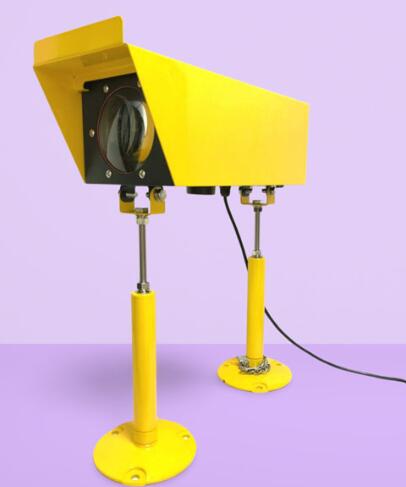HAPI System: Precision in Helicopter Approach and Landing
In aviation, safety and accuracy are paramount, particularly for helicopter operations. The Helicopter Approach Path Indicator (HAPI) system is a vital tool designed to enhance these aspects. By providing pilots with clear visual guidance during approach and landing, the HAPI system ensures precise alignment with the designated landing zone, reducing risks and improving efficiency. Whether used in military, offshore, or urban scenarios, this system is integral to modern aviation safety.
What is a HAPI System?
The HAPI system is a visual aid used to guide helicopter pilots during the final approach to a landing area. It operates by projecting a series of light beams that indicate whether the helicopter is on the correct glide slope. These lights provide instant feedback, showing whether the pilot is too high, too low, or on the proper approach path.

This system is especially useful in challenging environments where obstacles, adverse weather, or low visibility might complicate landings. The HAPI system’s straightforward visual cues enhance situational awareness, enabling pilots to make real-time adjustments.
Components of a HAPI System
The HAPI system consists of several critical components that work together to provide accurate and reliable guidance:
| HAPI system | HAPI systems |
Light Source
The core of the system is its light source, which emits beams in different colors or intensities. These variations indicate the helicopter's position relative to the ideal glide slope.
Optical Projector
The optical projector directs the light beams into specific patterns, ensuring pilots can easily interpret their position. The system projects these lights at precise angles to correspond with the desired approach path.
Control Unit
The control unit manages the HAPI system’s operation, ensuring it functions correctly under various conditions. Modern systems often include features like intensity adjustments based on ambient lighting or weather conditions.
Mounting System
The HAPI unit is typically mounted near the landing area, positioned to provide unobstructed visibility for incoming pilots. The mounting system ensures stability and correct alignment of the light beams.
How the HAPI System Works
The HAPI system operates by projecting light beams at different angles relative to the ideal glide slope:
On Glide Slope: Pilots see a steady beam of green light, indicating they are on the correct approach path.
Below Glide Slope: A red light warns the pilot that the helicopter is descending too steeply.
Above Glide Slope: A white light signals the pilot is too high and needs to adjust.
This straightforward visual feedback enables pilots to maintain proper alignment throughout the approach, ensuring a safe and accurate landing.
Advantages of the HAPI System
Enhanced Safety
The primary benefit of the HAPI system is improved safety. By providing clear visual guidance, it reduces the risk of accidents caused by misaligned approaches or poor visibility.
Precision and Accuracy
Helicopter operations often occur in challenging environments, such as offshore platforms or urban rooftops. The HAPI system ensures precision, helping pilots land accurately even in tight or obstacle-dense locations.
Ease of Use
The system’s visual cues are intuitive and easy to interpret, minimizing pilot workload during critical phases of flight. This simplicity is especially valuable during high-stress situations, such as emergency landings.
Weather Resilience
Adverse weather can severely impact visibility and situational awareness. The HAPI system remains effective in such conditions, providing consistent guidance to pilots.
Adaptability
The HAPI system is versatile and can be installed in a variety of locations, including hospitals, offshore platforms, military bases, and temporary landing zones. Its adaptability makes it suitable for diverse operational needs.
Applications of the HAPI System
The HAPI system is used in various sectors, each with unique requirements:
Emergency Medical Services: Hospitals equipped with HAPI systems can facilitate safe and efficient helicopter landings during critical medical evacuations, regardless of the time of day or weather conditions.
Offshore Platforms: Oil rigs and other offshore facilities rely on HAPI systems to guide helicopters safely onto confined and often elevated landing areas.
Military Operations: In military settings, precision is critical. The HAPI system supports tactical and logistical helicopter movements, ensuring safe landings even in combat zones.
Urban Air Mobility: As urban air mobility grows, rooftop heliports and vertiports are incorporating HAPI systems to ensure the safety of aerial traffic in densely populated areas.
Innovations in HAPI Systems
Modern HAPI systems are incorporating advanced technologies to enhance functionality and efficiency:
LED Technology
LED-based HAPI systems offer greater brightness, energy efficiency, and durability compared to traditional light sources. They are ideal for high-demand environments.
Portable Units
Portable HAPI systems are designed for temporary or remote operations, allowing for quick deployment in emergency or military scenarios.
Integration with Navigation Systems
Advanced HAPI systems can integrate with GPS or automated flight systems, providing additional layers of guidance for pilots.
Remote Monitoring and Control
Some systems feature remote monitoring capabilities, allowing operators to adjust settings or diagnose issues without being on-site.
Solar-Powered Systems
Solar-powered HAPI units offer sustainable solutions for remote locations, reducing reliance on traditional energy sources.
Challenges and Considerations
While the HAPI system offers numerous benefits, its effectiveness depends on proper installation and maintenance. The system must be correctly aligned to ensure accurate light projections, and regular inspections are required to maintain reliability. Additionally, training pilots to interpret the visual cues effectively is essential for maximizing the system’s benefits.
The HAPI system is a cornerstone of safe and efficient helicopter operations, providing pilots with the visual guidance needed for precise landings. Its simplicity, adaptability, and reliability make it indispensable across various sectors, from emergency services to offshore platforms. As technology continues to advance, the HAPI system is evolving to meet the growing demands of modern aviation, ensuring safety and precision remain at the forefront of helicopter operations.
